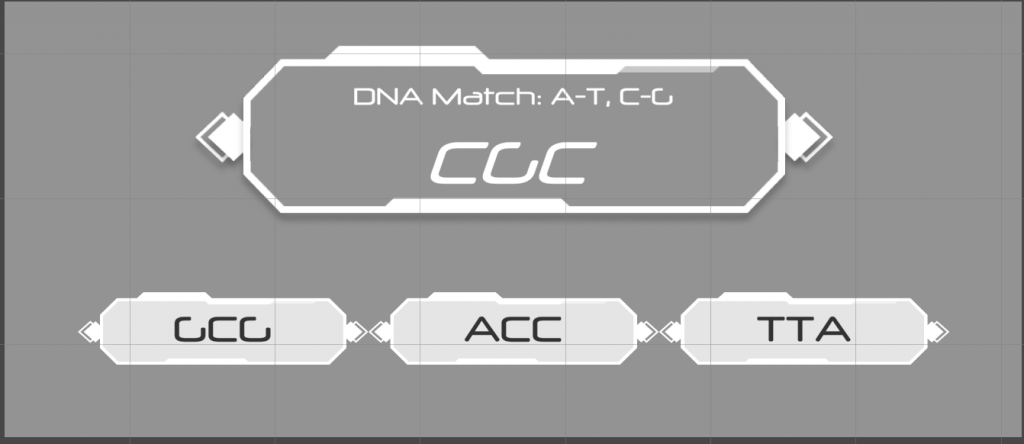Alpha has arrived – we’ve completed our core game loop and have moved on primarily to filling out content, art, and upgrading the mechanics.
Programming
Remote Server
The remote server build and setting up remote multiplayer is working smoothly now, we no longer have to debug server issues and pretty much any iteration of the game build can get copied up to the remote server and played without issues.
Human Tasks
For alpha we wanted to build out the first major task for the human players to interact with. Building the DNA Synthesis minigame layed a lot of foundational deisgn work in terms of understanding the limitations of what we would be doing with our minigames, what is possible using the UI, and the time constraints required to make one of these.

The game is pretty simple – players must match a DNA base pair sequence to its corresponding match. There are three rounds, starting with strings of length 3 going up to 5 characters. Clicking the correct answer progresses you one stage forward, and failing sets you back to the start.
The process of building out the level progressed as such:
1. Program the base functionality of the game (generating the DNA sequences and fake solutions) (approximately 2 hours)
2. Design the prefab, with its corresponding UI elements and planned interface. (approx. 1 hour)
3. Link up the functionality to the UI, filling out the additional features that come along with linking everything up, such as failing back to the beginning, properly updating the UI, etc. (approx 3 hours)
4. Debugging (approx ?? so far another 2 hours) There are still a couple of bugs with the tasks left to iron out, which should hopefully be one time issues that don’t add development time to future tasks, but future games of roughly this level of complexity will likely take about the same amount of time (subtracting time due to increased familiarity, adding time back anyways just because game dev is hard like that) of about 5-7 hours.
Visuals
Level Assets
We added new 3d assets for the level along with some UV mapping for pretty baked global illumination.

Animations
A whole slew of new models and animations were added for the parasite and human player models.


Player Identification
Each player has an assigned color attached to their playermodel so they can be recognized at a glance – they also have usernames over their heads that match the username they chose on the main menu.

UI
This week we also did some 2D design for UI. Based on the game concept, the sci-fi style is the main direction we went for. Also, it should not be too heavy in order to fit our player characters. Geometry shapes, parallel lines and the use of 45 degree angles are the building blocks for the interface. To combine elements into UI, we play with effects like overlay, floating, repeating and transparency. The font for button and titles are futuristic.

Audio
On the audio side, this week was mainly about implementing all of the core SFX and music. Using fmod, there are slight randomizations for each of the core sounds including footsteps, various parasite impacts, and all the sounds that the parasites make when performing actions. By slightly altering the pitch, volume, or sometimes combinations of sounds, the audio of the environment as a whole will hopefully feel more alive and less predictable. We have also added an approximately 2 minute long looping soundtrack for the background of the level. Musically, it should sound mischievous and fun without being threatening. The timbres used are primarily orchestral to evoke a similar feeling to that of old cartoon animations. Synth elements are mixed in to ground these orchestral sounds into our sci-fi environment.